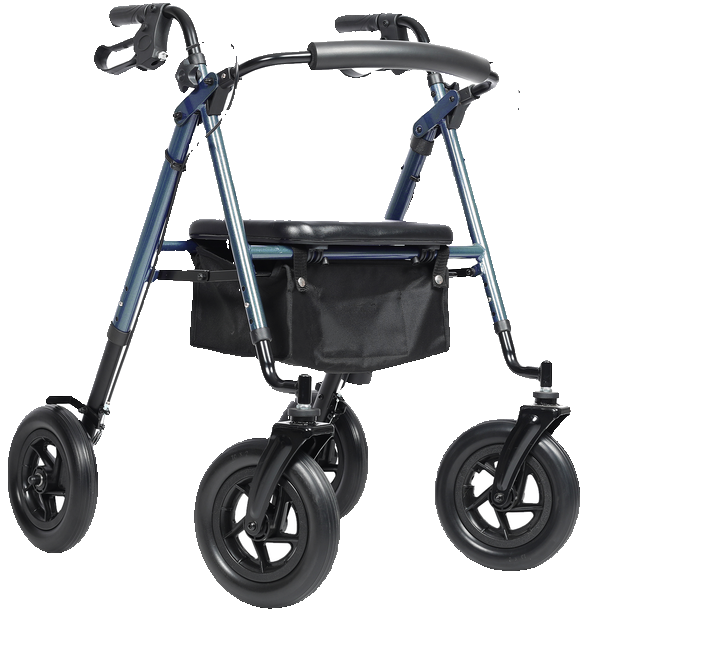Rollator Walker vs Walking Frame: Which One is Right for You?
The rollator walker and walking frame are two types of mobility aids that individuals may use to maintain their independence while walking. Both are intended to provide support and stability for those experiencing difficulty walking. However, choosing the right aid can be a challenging task given their differences in features and benefits.
In this article, we will examine the discrepancies between the two aids and determine which one is most suitable for particular individuals based on their unique needs and preferences.


What is a Rollator Walker?
A rollator walker is a mobility aid with four wheels and a built-in seat. It is engineered to reduce the overall effort required to walk while providing support and stability. It incorporates hand brakes that allow the user to control their speed and prevent the walker from moving forward. Rollators are best suited for people who have difficulties bending or frequently require rest while walking. They feature a cushioned seat, storage basket, and adjustable handlebars, and come in a variety of styles and sizes from small and compact models to larger ones with more advanced features.
The latest rollator models have electric drive capabilities that enable the device to move automatically without the need for manual operation, rendering them a more sophisticated option.
What is a Walking Frame?
A walking frame, also referred to as the Zimmer frame, is a mobility aid designed to provide support for individuals while walking. It consists of a metal frame with four legs and no wheels or additional features. Walking frames are ideal for individuals requiring a high level of support and stability while walking due to neurological disorders or injuries that affect their balance and coordination.
In addition, walking frames are available in various styles, including narrow, wide, and adjustable frames, and can be customized with different types of handles and grips to cater to the individual user's unique mobility needs.
NEWSLETTER
Key Differences Between a Rollator Walker and a Walking Frame
Now that we know what rollator walkers and walking frames are, let us discuss their differences. Understanding these differences can help you decide which device is suitable for you or your loved one.
Design and Features:
One of the most notable differences between rollator walkers and walking frames is their design and features. Rollator walkers typically feature four wheels, brakes, a built-in seat, and storage basket. The wheels ensure easy maneuverability, while the brakes provide increased safety while walking. Rollators also have a broader base to ensure better stability, making them a more suitable option for individuals with balance or coordination issues. In contrast, walking frames have a metal frame with four legs and no wheels or additional features. This simple design provides stability and support while walking but does not offer the same level of convenience or additional features as a rollator walker.
Support and Stability:
Rollator walkers provide more support and stability compared to walking frames, thanks to their wider base and four wheels that provide additional stability when walking. Rollators incorporate hand brakes that allow the user to control their speed or stop the walker from moving forward, providing an additional level of safety. Walking frames provide support for individuals who have difficulty walking but do not offer the same level of stability as rollator walkers.
Portability:
Rollator walkers are designed to be portable compared to walking frames. Folding mechanisms in rollators allow for easy storage in car trunks or carrying onto public transportation, making them a great option for individuals who need to travel frequently or who have limited storage space at home. In contrast, walking frames are not designed to be easily transported and are better suited for use in the home or care facility.

Which One is Right for You?
The decision between a rollator walker and a walking frame depends on your specific needs. If you require a high level of support and stability while walking, a walking frame may be the best choice. However, if you need more mobility and support while walking, a rollator walker may be the better option. Other factors, such as the terrain you'll be walking on, your balance, and your overall mobility, can also play a role in determining which mobility aid is right for you.
It is essential to consult with your healthcare provider or mobility expert before purchasing a walking aid. They can help you make an informed decision based on your unique needs and requirements. In addition, if deemed medically necessary and prescribed by a doctor, insurance may cover the cost of a mobility aid.
Conclusion
Rollator walkers and walking frames are two different types of mobility aids that provide support and stability while walking. They each present unique features and benefits, and the choice between the two depends on the individual's specific needs and preferences. By understanding the differences between the two, individuals can determine the most suitable mobility aid for them.
